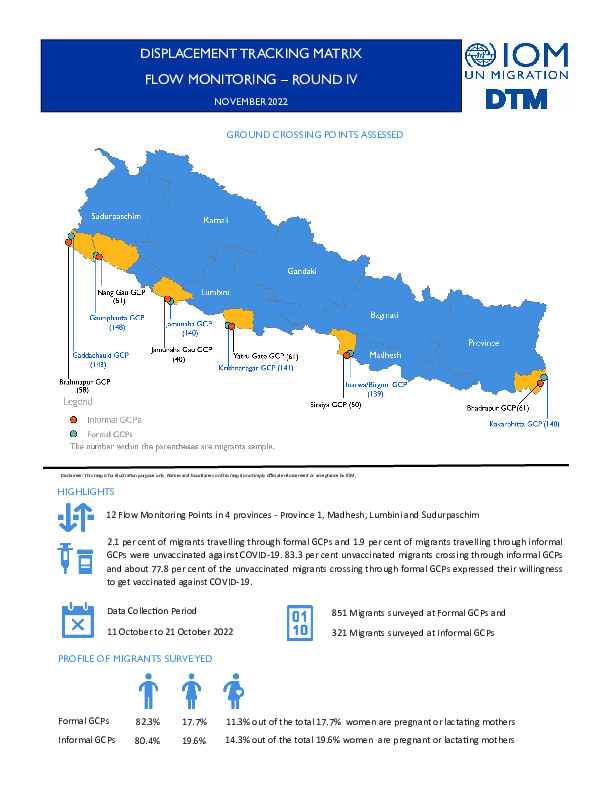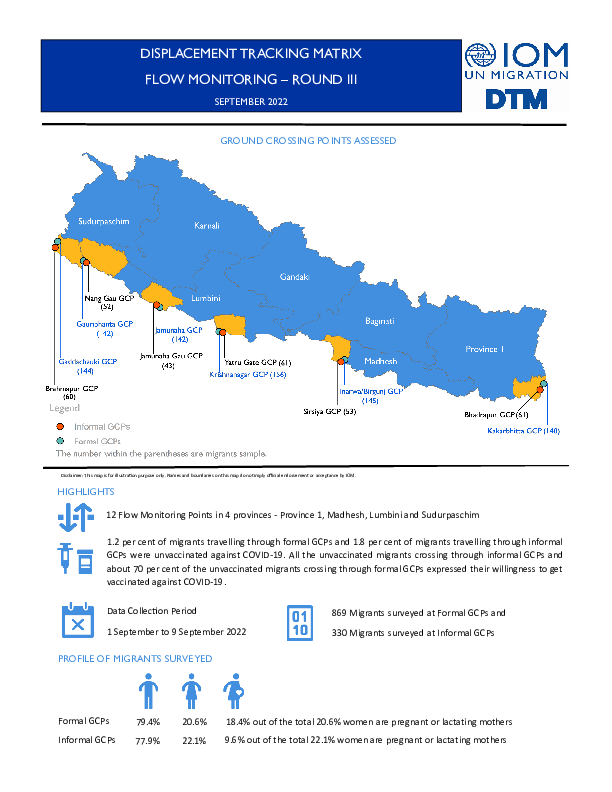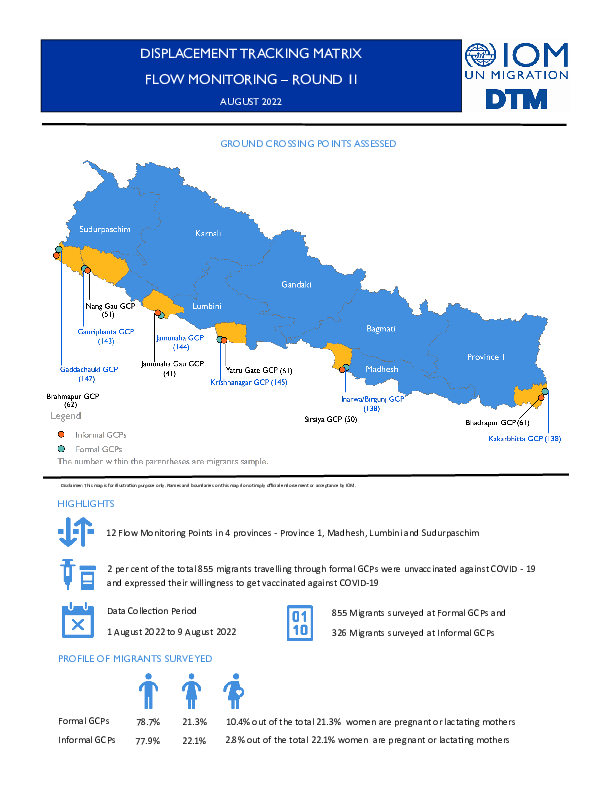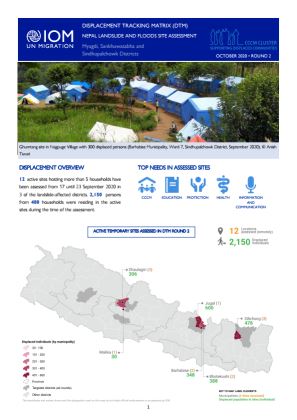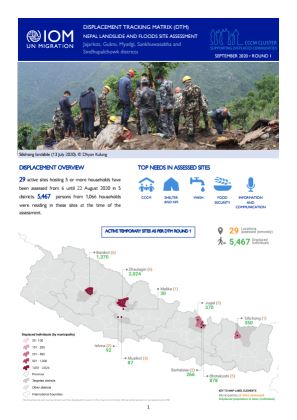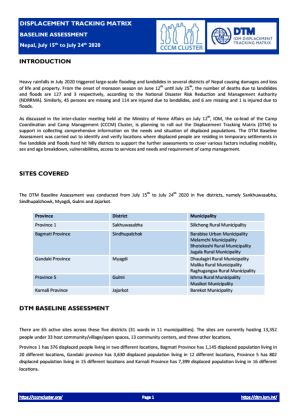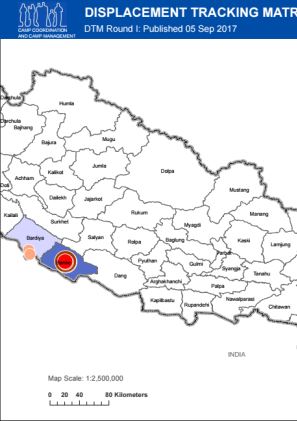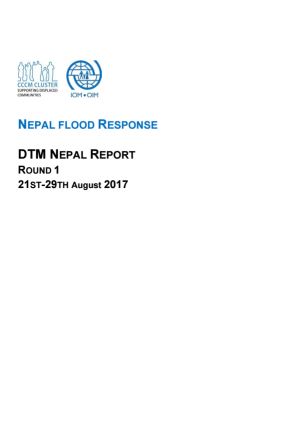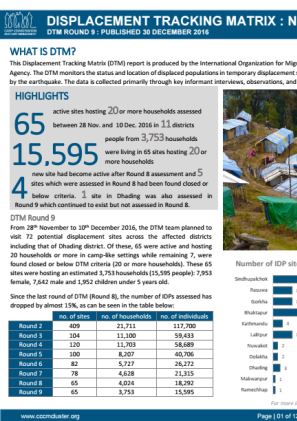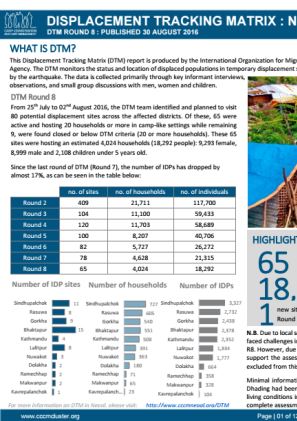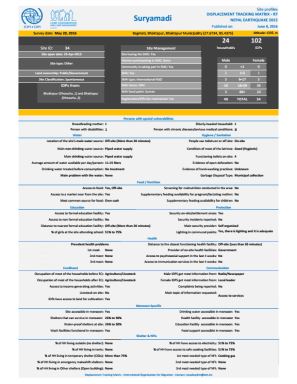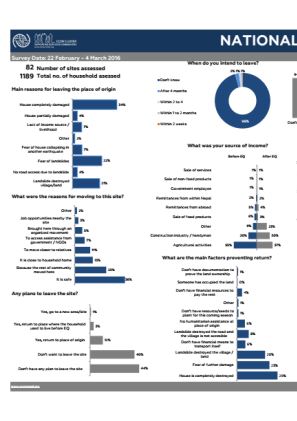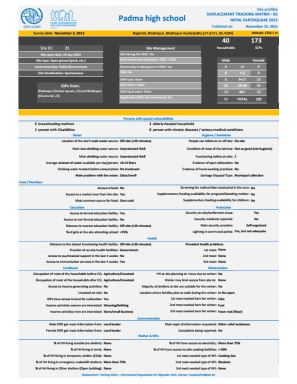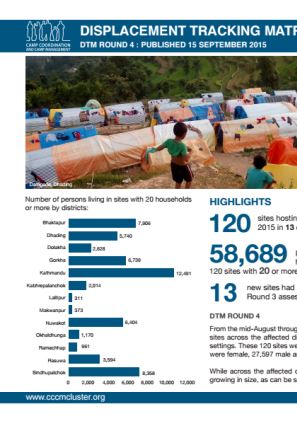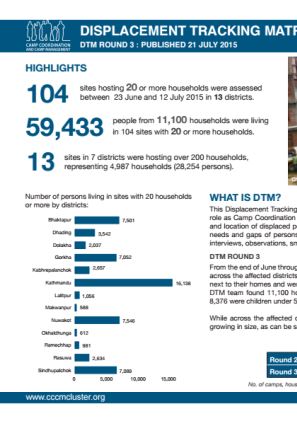-
Countries
-
Data and Analysis
-
Special Focus
-
Crisis Responses
Nepal
Nepal
Suivi des PDI
Mouvements de déplacement
Aucun chiffre n’est disponible
IDMC 2023
cycle de collecte de données
À propos Nepal
The International Organization for Migration (IOM), as the Global Cluster Lead for Camp Coordination and Camp Management (CCCM) in emergencies induced by natural disasters, uses the Displacement Tracking Matrix as the main tool for tracking and monitoring sites and camps hosting internally displaced populations. DTM regularly captures, processes, and disseminates various layers of information to provide a better understanding of the evolving needs of the displaced population, their locations and movements.
In Nepal, DTM maps populations in displacement sites (including spontaneous settlements) across the affected districts and record their priority needs at community level, in order to inform camp management and site facilitation (where required), and the broader humanitarian response. In the second phase, more detailed information will be sought at household and individual level on the reasons why people are unable to return home from the displacement sites, in order to identify opportunities for durable solutions.
Contacter
DTM Nepal
NepalEQDTM@iom.int
Nepal — Flow Monitoring Survey — Round 4 (November 2022)
IOM Nepal collected data at 12 ground crossing points (GCPs) - six formal and six informal, to better understand the migration between India and Nepal.
Nepal — Flow Monitoring Survey — Round 3 (September 2022)
IOM Nepal collected data at 12 ground crossing points (GCPs) six formal and six informal, in an effort to better understand the migration movements between India and Nepal.
Nepal — Flow Monitoring Survey — Round 2 (August 2022)
IOM Nepal collected data at 12 ground crossing points (GCPs) six formal and six informal, in an effort to better understand the migration movements between India and Nepal.
Nepal — Flow Monitoring Survey — Round 1 (July 2022)
IOM Nepal collected data at 12 ground crossing points (GCPs) six formal and six informal, in an effort to better understand the migration movements between India and Nepal.
Nepal – Landslides and Floods Displacement – Site Assessment Round 2 (October 2020)
Heavy monsoon rainfall in July 2020 triggered large scale flooding and landslides in several district across Nepal. From the onset of monsoon on 12 June until September 2020, the number of deaths due to landslides, floods and lightning has reached 363.
Nepal – Landslides and Floods Displacement – Site Assessment Report (September 2020)
Heavy rainfall in July 2020 triggered large-scale flooding and landslides in several districts across Nepal. From the onset of monsoon on 12 June until 1 September 2020, the number of deaths due to landslides, floods and lightning is 282.
Nepal – Landslides and Floods Displacement – Baseline Assessment Report (15 July- 24 July)
Large-scale flooding and landslides have been triggered in several districts across Nepal following heavy rainfalls in July 2020.
Nepal — Flood Displacement Dashboard 1 (5 September 2017)
This Flood Displacement Dashboard created on 3 September 2017 shows the number of displaced individuals in Nepal.
Nepal — Flood Displacement Report 1 (21—29 August 2017)
This Flood Displacement Report found that out of the 5,072 displaced persons from 1,045 households covered by DTM, 100 percent of sites are spontaneous settlements. The most common type of shelter is makeshift/tarpaulin which accounted for 67 percent of sites. 50 percent
Nepal — Earthquake Displacement Report 9 (28 November—10 December 2016)
The DTM assessed 65 active sites hosting 20 or more households between 28 November and 10 December 2016 in 11 districts. 15,595 people were living in 65 sites. Since round 8 (25th July to 2 August 2016), 4 new sites had become active and 5 previously sites had closed.
Nepal — Earthquake Displacement Report 8 (25 July — 2 August 2016)
From 25th July to 2 August 2016, the DTM team identified and planned to visit 80 potential displacement sites across the affected districts.
Nepal — Earthquake District Profiles 7 (11—20 May 2016)
This is a collection of one national and 12 district profiles from DTM round 7.
Nepal — Earthquake Displacement Site Profiles 7 (10—20 May 2016)
This is a collection of 78 site profiles from DTM round 7.
Nepal — Earthquake Displacement Report 7 (10—20 May 2016)
From 9 May to 20 May 2016, the DTM team identified and visited 89 potentialdisplacement sites across the affected districts. Of these, 78 were active andhosting 20 households or more in camp-like settings while remaining 11, including
Nepal — Earthquake Return Intention Survey (March 2016)
This report presents the outcome of the survey on return intentions undertaken in several cities in the country from 22 February - 4 March 2016.
Nepal — Earthquake Displacement Report 6 (22 February — 6 March 2016)
From 22nd February to 6th March 2016, the DTM team identified and visited 107 potential displacement sites across the affected districts.
Nepal — Earthquake Displacement Site Profiles 5 (15 September — 20 November 2015)
This document contains site profiles for 100 displacement sites identified in Round 5 DTM assessments.
Nepal — Earthquake District Profiles 5 (15 September — 20 November 2015)
This document contains 12 district profiles and one national overview from Round 5 DTM assessments.
Nepal — Earthquake Displacement Report 5 (15 September — 20 November 2015)
From mid-September through to 20 November 2015, the DTM team identified and visited 140 potential displacement sites across the affected districts.
Nepal — Earthquake Displacement Report 4 (15 August — 5 September 2015)
147 potential displacement sites across the affected districts were identified in Round 4 assessments. Of these, 120 were active and hosting 20 households or more in camp-like settings. These 120 sites were hosting an estimated 11,703 households (58,689 people).
Nepal — Earthquake Displacement Report 3 (30 June — 12 July 2015)
286 potential displacement sites across the affected districts were identified in Round 3 assessments. Of these, 107 were closed, 75 were hosting fewer than 20 households or dispersed next to their homes and were therefore not included in the assessments.
Nepal – Earthquake Return Intention Survey (July 2015)
This report presents the outcome of the survey on return intentions undertaken in several cities in the country from 23 June - 11 July 2015.
Nepal — Earthquake Displacement Report 2 (30 April — 8 June 2015)
Round 2 assessments identified 409 displacement sites in fifteen earthquake-affected districts, hosting an estimated 117,700 people from 21,711 households. 77 priority sites of more than 50 households are hosting 49,118 people.
Nepal — Earthquake Displacement Report 1 (2—7 May 2015)
Round 1 assessments identified 5,783 IDPs in 53 sites in Kathmandu, Bhaktapur and Lalitpur districts. Sites are 98% spontaneous settlements and 2% collective centres.
Nepal — Baseline Assessment - Floods 2020 — Round 1
2020-07-24
A baseline assessment is a sub-component of mobility tracking. It aims to collect data on IDP, migrant or returnee population presence in a defined administrative area of the country. This dataset presents a summary of the number of displaced individuals at the wards level of data collected by DTM…
Nepal — Site Assessment Round # 1 Floods 2017
2017-08-29
A site assessment is a sub-component of mobility tracking. It aims to collect data on IDP, migrant or returnee population presence in a defined administrative area of the country.
Nepal — Site Assessment Round 4 EQ2015
2015-09-06
A site assessment is a sub-component of mobility tracking. It aims to collect data on IDP, migrant or returnee population presence in a defined administrative area of the country.
Nepal — Site Assessment Round 1 EQ2015
2015-05-13
A site assessment is a sub-component of mobility tracking. It aims to collect data on population presence, living conditions and needs in a particular displacement site or community.


